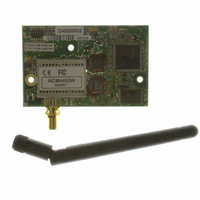20-101-1221 Rabbit Semiconductor, 20-101-1221 Datasheet - Page 44

20-101-1221
Manufacturer Part Number
20-101-1221
Description
RCM4400W (JAPAN TELEC CERTIFIED)
Manufacturer
Rabbit Semiconductor
Series
RabbitCore®r
Datasheet
1.20-101-1202.pdf
(126 pages)
Specifications of 20-101-1221
Frequency
2.4GHz
Modulation Or Protocol
802.11 b
Power - Output
16dBm
Voltage - Supply
3.3V
Current - Receiving
450mA
Current - Transmitting
450mA
Data Interface
Connector, 2 x 25 Header
Memory Size
512K Flash, 1MB SRAM
Antenna Connector
SMA
Operating Temperature
-20°C ~ 85°C
Package / Case
Module
Lead Free Status / RoHS Status
Lead free / RoHS Compliant
Applications
-
Sensitivity
-
Data Rate - Maximum
-
Other names
316-1147
- Current page: 44 of 126
- Download datasheet (2Mb)
4.2.2 Wi-Fi
Figure 9 shows a functional block diagram for the Wi-Fi circuits.
Figure 9. RCM4400W Wi-Fi Block Diagram
The Wi-Fi transmission is controlled by the onboard FPGA chip at U14. The primary
functions of this FPGA are to implement the 802.11b baseband Media Access Control
(MAC) functionality, and to control the 802.11b integrated UBEC UW2453 transceiver.
The serial flash programs the FPGA automatically whenever power is applied. Once con-
figured, the FPGA performs all of the 802.11b data encoding and decoding, radio configu-
ration, and radio control functions.
The data interface between the FPGA and the UBEC UW2453 based 802.11b radio section
consists of a D/A converter and an A/D converter. Both devices convert “I” and “Q” data
samples at a rate of 40 MHz.
The UBEC UW2453 is a single-chip transceiver with integrated power amplifier for the
2.4 GHz Industrial, Scientific, and Medical (ISM) band. It is configured and controlled by
the FPGA via a 3-wire serial data bus. The UW2453 contains the entire receiver, transmit-
ter, VCO, PLL, and power amplifier necessary to implement an 802.11b radio.
The UW2453 can transmit and receive data at up to 11MBits/s in the 802.11b mode. It
supports 802.11b channels 1–13 (2.401 GHz to 2.472 GHz). The data modulate the chan-
nel carrier in such a way so as to produce a spread spectrum signal within the 22 MHz
channel bandwidth of the selected channel. The channel numbers and associated frequen-
cies are listed below in Table 4.
The Wi-Fi channels have a certain amount of overlap with each other. The further apart
two channel numbers are, the less the likelihood of interference. If you encounter interfer-
ence with a neighboring WLAN, change to a different channel. For example, use channels
1, 6, and 11 to minimize any overlap.
38
RabbitCore RCM4400W
Related parts for 20-101-1221
Image
Part Number
Description
Manufacturer
Datasheet
Request
R

Part Number:
Description:
COMPUTER SGL-BRD BL2500 29.4MHZ
Manufacturer:
Rabbit Semiconductor
Datasheet:

Part Number:
Description:
COMPUTER SGL-BRD BL2500 29.4MHZ
Manufacturer:
Rabbit Semiconductor
Datasheet:

Part Number:
Description:
DISPLAY GRAPHIC 12KEY PROG OP670
Manufacturer:
Rabbit Semiconductor
Datasheet:

Part Number:
Description:
DISPLAY GRAPHIC 12KEY ETH OP6700
Manufacturer:
Rabbit Semiconductor
Datasheet:

Part Number:
Description:
COMPUTER SINGLE-BOARD BL2030
Manufacturer:
Rabbit Semiconductor

Part Number:
Description:
COMPUTER SGL-BOARD ETH BL2010
Manufacturer:
Rabbit Semiconductor

Part Number:
Description:
MODULE OP6810 W/O ETH/MEM EXPANS
Manufacturer:
Rabbit Semiconductor
Datasheet:

Part Number:
Description:
COMPUTER SINGLE-BOARD BL2020
Manufacturer:
Rabbit Semiconductor

Part Number:
Description:
COMPUTER BL2010 W/FRICTION LOCK
Manufacturer:
Rabbit Semiconductor

Part Number:
Description:
COMPUTER BL2020 W/FRICTION LOCK
Manufacturer:
Rabbit Semiconductor

Part Number:
Description:
COMPUTER SGL-BRD BL2500 44.2MHZ
Manufacturer:
Rabbit Semiconductor
Datasheet:

Part Number:
Description:
COMPUTER SGL-BOARD FULL BL2000
Manufacturer:
Rabbit Semiconductor

Part Number:
Description:
COMPUTER SINGLE-BOARD BL2110
Manufacturer:
Rabbit Semiconductor

Part Number:
Description:
COMPUTER SGL-BRD 29.4MHZ BL2610
Manufacturer:
Rabbit Semiconductor
Datasheet:

Part Number:
Description:
INTERFACE OP6800 512K FLASH&SRAM
Manufacturer:
Rabbit Semiconductor
Datasheet:










